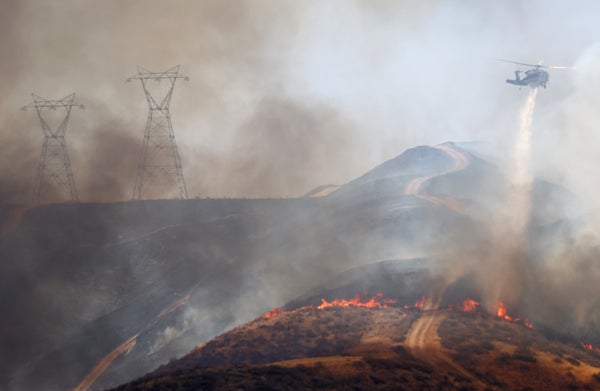CLIMATEWIRE | California is sweltering in a record-breaking September heat wave, sending electricity demand soaring and triggering repeated calls for residents to cut back on their power usage to prevent rolling blackouts.
Monday evening, electricity supplies had so far covered demand. But the California Independent System Operator (ISO) issued a stage one warning statewide that electricity supplies were nearing danger territory. Northern California entered stage two, where the grid manager seeks power from all sources and amps up calls for consumer conservation. Stage three can trigger rolling blackouts.
The ISO warned that “historic” demands for power in the coming days are “significantly increasing the likelihood of rotating outages.”
On supporting science journalism
If you're enjoying this article, consider supporting our award-winning journalism by subscribing. By purchasing a subscription you are helping to ensure the future of impactful stories about the discoveries and ideas shaping our world today.
The office of Gov. Gavin Newsom (D) also urged residents to decrease their power usage during “unprecedented temperatures.”
“This heat wave is on track to be both the hottest and longest on record in California for September,” the governor’s office said in a statement. “We are heading into the worst part of this heat wave and energy demands are expected to be at an all-time high.”
The warnings came as temperatures broke records over Labor Day weekend.
On Monday, Sacramento Executive Airport reached 114 degrees Fahrenheit, breaking the September record of 109 F set in 2020. Stockton hit 112 F, topping the September record of 111 F set in 2020. And Vacaville hit 115 F, 3 degrees hotter than the monthly record set in 2020.
On Sunday, Death Valley hit 124 F, breaking the daily record by 2 degrees.
Tuesday could be even more challenging. Forecasters expect the highest temperatures yet, and officials say electricity demand Tuesday could hit 51,145 megawatts — more than Monday. It would set a new record, topping the 50,270 MW of demand that hit on a July day in 2006.
Monday was the seventh day in a row that ISO issued what it calls a “Flex Alert,” asking residents to cut back on their power use. The alerts urge consumers to set their thermostats to 78 F or higher, avoid using major appliances and turn off unnecessary lights.
People cutting power usage on Sunday was estimated to save approximately 1,000 MW. A full analysis of the impact is expected in coming days.
ISO President and CEO Elliot Mainzer said in a statement Monday that that energy reduction needs to be “two or three times greater” as the heat wave intensifies Tuesday.
"We can’t control the weather, but we really can bend the demand curve and get through this successfully if everyone doubles down and reduces their energy use as much as possible,” he said.
The aim is to prevent a repeat of the rolling blackouts that hit the nation's most populous state during an extreme heat wave in August 2020. Electricity supplies were not enough to meet demand, and the ISO ordered rolling blackouts for a few hours on a Saturday evening and a short period the next evening.
Since then, California has beefed up supplies of battery storage and other types of green electricity, as it also seeks to make its grid carbon-neutral by 2045. While storage has increased, supply chain woes have blocked some renewable projects from coming online.
State officials and grid managers have been warning for months that power supply and demand could be tight during September for the next five years.
That prompted the state Legislature to pass a measure last week that extended the life of the Diablo Canyon nuclear power plant in San Luis Obispo County. Newsom signed the bill on Friday. The plant, the last nuclear facility operating in California, now will remain open through 2030.
The Legislature also just passed A.B. 2238, which would create the nation's first extreme heat ranking system. Newsom hasn’t yet signed the bill.
‘Directly related to global warming’
The heat dome baking California is an "extremely warm air mass" that moves in like a rain front, according to John Abatzoglou, climatology professor at the University of California, Merced. But instead of moving on quickly, it sticks around for days.
Scientists say such heat events are linked to the changing climate.
“Heat waves are the extreme events that are most directly related to global warming and most clearly impacted by it,” said Alexander Gershunov, a research meteorologist at the Scripps Institution of Oceanography at the University of California, San Diego. “So not only do we see very strong trends over the globe, but we expect those trends to continue and accelerate into the next couple of decades.”
Since the 1980s, heat waves have become increasingly more humid in California. That’s because the oceans are warmer, adding to the humidity, Gershunov said.
It’s also part of the reason that the nighttime temperatures don’t cool off as much as in past years. Death Valley, for example, had an overnight low of 102 F on Sept. 4, breaking a previous daily record of 100 F set in 2007.
In addition, in the western United States, climate change has triggered an earlier snow melt and thus drier soils in the summer.
“There's very little water to evaporate. And what that ends up meaning is that it's much easier to heat up the surface,” Abatzoglou said in an interview.
If there were more water in soils and grasses, he said hot air would go in part to evaporating that water.
“But when we have parched landscapes … that energy goes to heating the air,” he said.
Reprinted from E&E News with permission from POLITICO, LLC. Copyright 2022. E&E News provides essential news for energy and environment professionals.
